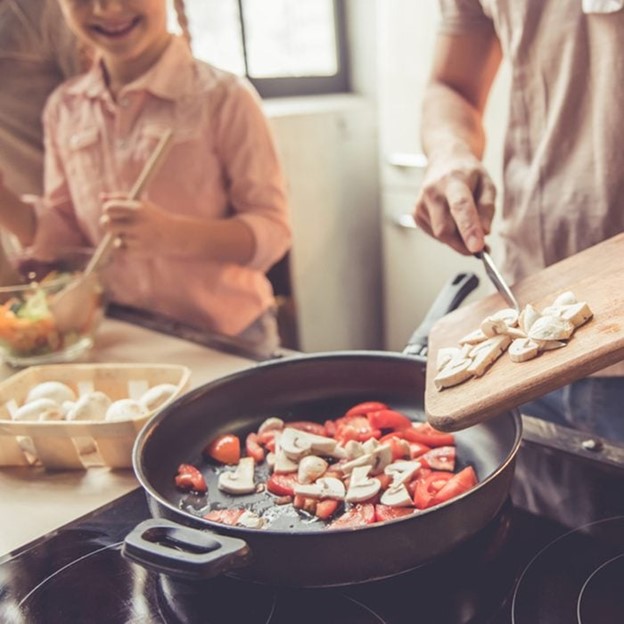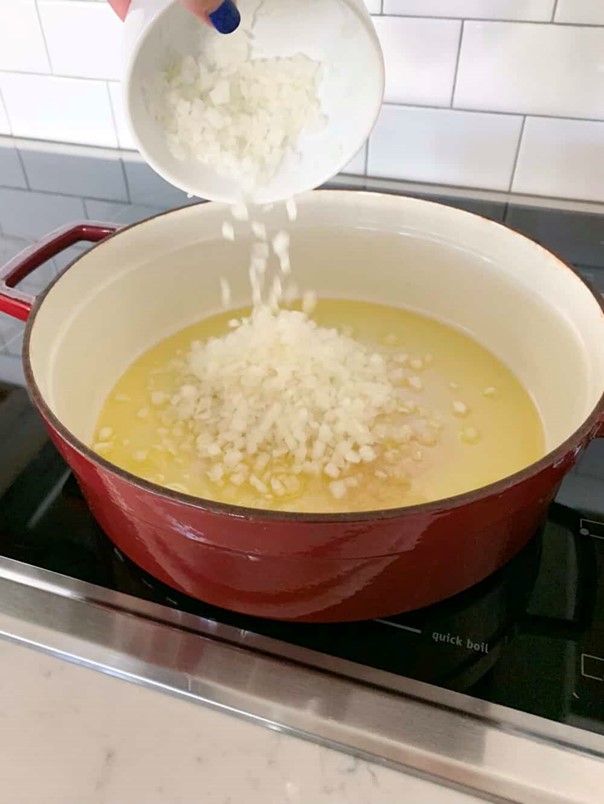Are You Making These Soup-Prepping Mistakes?
A few months ago, Kelsey Rae Dimberg, former Taste of Home Editor, wrote a hugely helpful article on how we can improve our homemade soups. Since I was making turkey noodle soup today with our Thanksgiving leftovers, I thought I’d read through what she had to say.
As homemade soups can sometimes wind up watery, bland or a bit mushy, I thought you, too, might be interested in what Kelsey shared about some very common mistakes people make when cooking soup. I’m quoting her:

Mistake 1: not starting with aromatics and fat. A little fat (typically butter and olive oil), is essential to making a robust soup. Fat is also a flavor vehicle, and helps to brown vegetables. Almost all soup recipes begin with aromatics cooked in hot fat. Aromatics are vegetables that add an overall flavor to the soup but aren’t the primary ingredients. Think onions, garlic, leeks, carrots, celery and herbs.
Mistake 2: not browning vegetables. It’s tempting to toss all your chopped ingredients into a pot, add the broth and simmer until tender. But if you take the time to brown all your ingredients before adding broth, you’ll be rewarded with extra flavor and sweetness. After the aromatics have cooked, drop in your chopped vegetables and allow to brown on all sides.

Mistake 3: not cooking onions through. Onions are strong enough to be the star of French onion soup, and they add an undeniable sweetness to the base of any soup. The trick, however, lies in cooking them thoroughly before any acidic ingredients, such as tomatoes or wine, are added. Once they’re cooked, you can add any ingredients. As a bonus, the longer you cook your onions, the more sweetness you’ll draw out.
Mistake 4: under-seasoning. Random research shows many cooks wait until the end of cooking to taste and season their soup. But adding salt and other spices early in the cooking process allows their flavors to blend into the entire soup—and adding salt to veggies right away actually pulls out more flavor from them.
Mistake 5: forgetting the umami. Savoriness can come from other ingredients besides salt. Adding umami-rich ingredients like tomato paste or a parmesan rind to the soup will add a deep, rich savoriness and body to the soup.

Mistake 6: over-seasoning. OVER-salting is common (especially if using store-bought broth). A few cups of plain broth or water will save it, but if you don’t want to water the soup down, add one or two unseasoned potatoes. Let the soup simmer and the spuds will soak up lots of the salty broth.
Mistake 7: not using broth or not making a quick broth. Of course, soup can be made with water, but it’s easy to make a quick broth using the scraps from the vegetables you’re prepping for the soup. Even butternut squash or sweet potato peels simmered in water for a few moments makes a quick broth that’s much more flavorful than plain water.
Mistake 8: cooking grains IN the soup. When you add pasta or rice directly into the simmering soup, it soaks up tons of liquid as it cooks (even more as the soup cools). For best results, cook grains or pasta separately, and then ladle into soup bowls.

Mistake 9: not using an immersion blender for pureeing. Pouring hot soup into a blender can be precarious. An immersion blender (aka stick blender) makes this safer, easier, and tidier.
Mistake 10: not adding an acid. If your soup tastes bland, consider adding acid (lemon or lime juice, white wine, vinegar, plain yogurt or sour cream). Just a smidge makes a huge difference.
Mistake 11: always following a recipe. Yes, some recipes should be followed exactly (i.e. for baked goods). But soup recipes usually do well with creativity, because they’re inherently flexible. So don’t hesitate to include the veggies languishing in the crisper drawer (but follow the above advice and saute first). Soups are also the perfect way to use leftover chicken or cooked meat.
As homemade soups can sometimes wind up watery, bland or a bit mushy, I thought you, too, might be interested in what Kelsey shared about some very common mistakes people make when cooking soup. I’m quoting her:

Mistake 1: not starting with aromatics and fat. A little fat (typically butter and olive oil), is essential to making a robust soup. Fat is also a flavor vehicle, and helps to brown vegetables. Almost all soup recipes begin with aromatics cooked in hot fat. Aromatics are vegetables that add an overall flavor to the soup but aren’t the primary ingredients. Think onions, garlic, leeks, carrots, celery and herbs.
Mistake 2: not browning vegetables. It’s tempting to toss all your chopped ingredients into a pot, add the broth and simmer until tender. But if you take the time to brown all your ingredients before adding broth, you’ll be rewarded with extra flavor and sweetness. After the aromatics have cooked, drop in your chopped vegetables and allow to brown on all sides.

Mistake 3: not cooking onions through. Onions are strong enough to be the star of French onion soup, and they add an undeniable sweetness to the base of any soup. The trick, however, lies in cooking them thoroughly before any acidic ingredients, such as tomatoes or wine, are added. Once they’re cooked, you can add any ingredients. As a bonus, the longer you cook your onions, the more sweetness you’ll draw out.
Mistake 4: under-seasoning. Random research shows many cooks wait until the end of cooking to taste and season their soup. But adding salt and other spices early in the cooking process allows their flavors to blend into the entire soup—and adding salt to veggies right away actually pulls out more flavor from them.
Mistake 5: forgetting the umami. Savoriness can come from other ingredients besides salt. Adding umami-rich ingredients like tomato paste or a parmesan rind to the soup will add a deep, rich savoriness and body to the soup.

Mistake 6: over-seasoning. OVER-salting is common (especially if using store-bought broth). A few cups of plain broth or water will save it, but if you don’t want to water the soup down, add one or two unseasoned potatoes. Let the soup simmer and the spuds will soak up lots of the salty broth.
Mistake 7: not using broth or not making a quick broth. Of course, soup can be made with water, but it’s easy to make a quick broth using the scraps from the vegetables you’re prepping for the soup. Even butternut squash or sweet potato peels simmered in water for a few moments makes a quick broth that’s much more flavorful than plain water.
Mistake 8: cooking grains IN the soup. When you add pasta or rice directly into the simmering soup, it soaks up tons of liquid as it cooks (even more as the soup cools). For best results, cook grains or pasta separately, and then ladle into soup bowls.

Mistake 9: not using an immersion blender for pureeing. Pouring hot soup into a blender can be precarious. An immersion blender (aka stick blender) makes this safer, easier, and tidier.
Mistake 10: not adding an acid. If your soup tastes bland, consider adding acid (lemon or lime juice, white wine, vinegar, plain yogurt or sour cream). Just a smidge makes a huge difference.
Mistake 11: always following a recipe. Yes, some recipes should be followed exactly (i.e. for baked goods). But soup recipes usually do well with creativity, because they’re inherently flexible. So don’t hesitate to include the veggies languishing in the crisper drawer (but follow the above advice and saute first). Soups are also the perfect way to use leftover chicken or cooked meat.
 Alice Osborne
Alice Osborne
Weekly Newsletter Contributor since 2006
Email the author! alice@dvo.com
